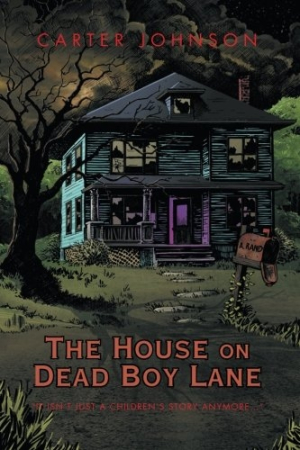The House on Dead Boy Lane
Eerie monsters and psychological demons creep from the shadows of Johnson’s vivid occult mystery.
Haunted houses are a staple of horror novels, but few are quite as patently evil as the seemingly abandoned home at the heart of Carter Johnson’s fiction debut. With more than a passing nod to the monarch of modern horror, Stephen King, The House on Dead Boy Lane capably, if not seamlessly, combines an adolescent coming-of-age story with a shocking occult mystery.
Each aspect of Johnson’s story is fully imagined and engaging, though the parts aren’t always fully integrated. For instance, Johnson’s opening pages deliver a fascinating history of his setting, Tanner’s Ridge, North Carolina, complete with its gold rush beginnings, the creation of the strange house at 325 Hanson Circle, and the grisly murders that have happened there. It’s an engaging rural backdrop, reminiscent of Stephen King’s Castle Rock, Maine, but these opening pages stand outside the story, rather than drawing readers immediately into the action.
The action centers on Derek, an awkward teenager trying to figure out how to fit into his new town and school. His teenage world is rich with authentic detail, like flirting on back steps and behind the bleachers when adults are not around. Though Johnson’s descriptions are sometimes overly exhaustive—he describes each cigarette smoked by Derek’s new girlfriend, Alex, for instance—he effectively draws readers into his characters’ world. At the same time, creepy images from the haunted house come graphically to life: the blood-stained walls aren’t a mere metaphor. This place is for real, as Johnson clearly shows.
Suspense builds slowly in The House on Dead Boy Lane, and it’s well into the final third of the novel when the teens and the house come together. Once the evil is unleashed, Johnson keeps the tension high as Derek, Alex, and friends attempt to fend off their otherworldly foe. The sense of foreboding that has been gradually building comes to a crescendo here, as the kids confront the gruesome, relentlessly needy creature that has lured them into the house. Their attempts to escape will keep the pages turning, and though most scenes are fairly standard horror fare, Johnson does save an unexpected twist for the very end.
There are plenty of eerie monsters to satisfy the most jaded horror fans, though it’s the psychological demons that truly spook the reader. Alex’s dreams—and, indeed, her waking life—become infiltrated by disturbingly violent visions related to the house. Is Alex simply a troubled teen, or is she possessed? That’s the question that really drives the action here, and convinces the reader to go along for the ride. Again, Johnson follows in the footsteps of a master, and many readers will draw parallels between King’s Carrie and Johnson’s Alex.
Johnson pulls no punches in The House on Dead Boy Lane. Dark, disturbing psychological moments pair with violent physical brutality in ways that readers may not expect from its uninhabited cover image. But walk down that overgrown path and look in the shattered windows of the decaying house pictured there and find a vivid, dramatic story within.
Reviewed by
Sheila M. Trask
Disclosure: This article is not an endorsement, but a review. The publisher of this book provided free copies of the book and paid a small fee to have their book reviewed by a professional reviewer. Foreword Reviews and Clarion Reviews make no guarantee that the publisher will receive a positive review. Foreword Magazine, Inc. is disclosing this in accordance with the Federal Trade Commission’s 16 CFR, Part 255.

